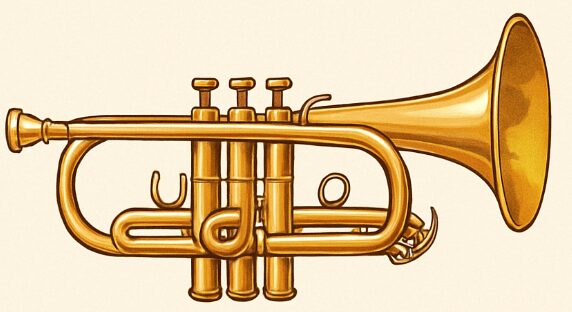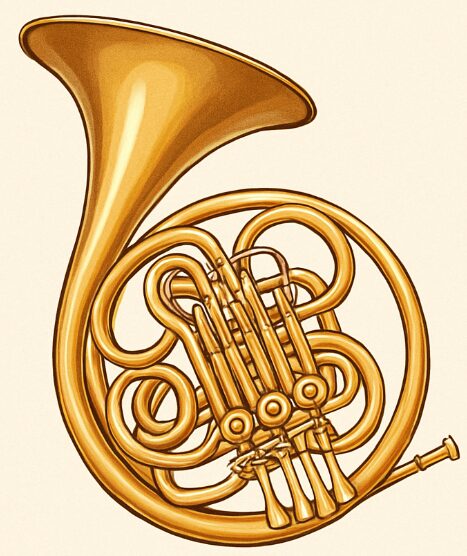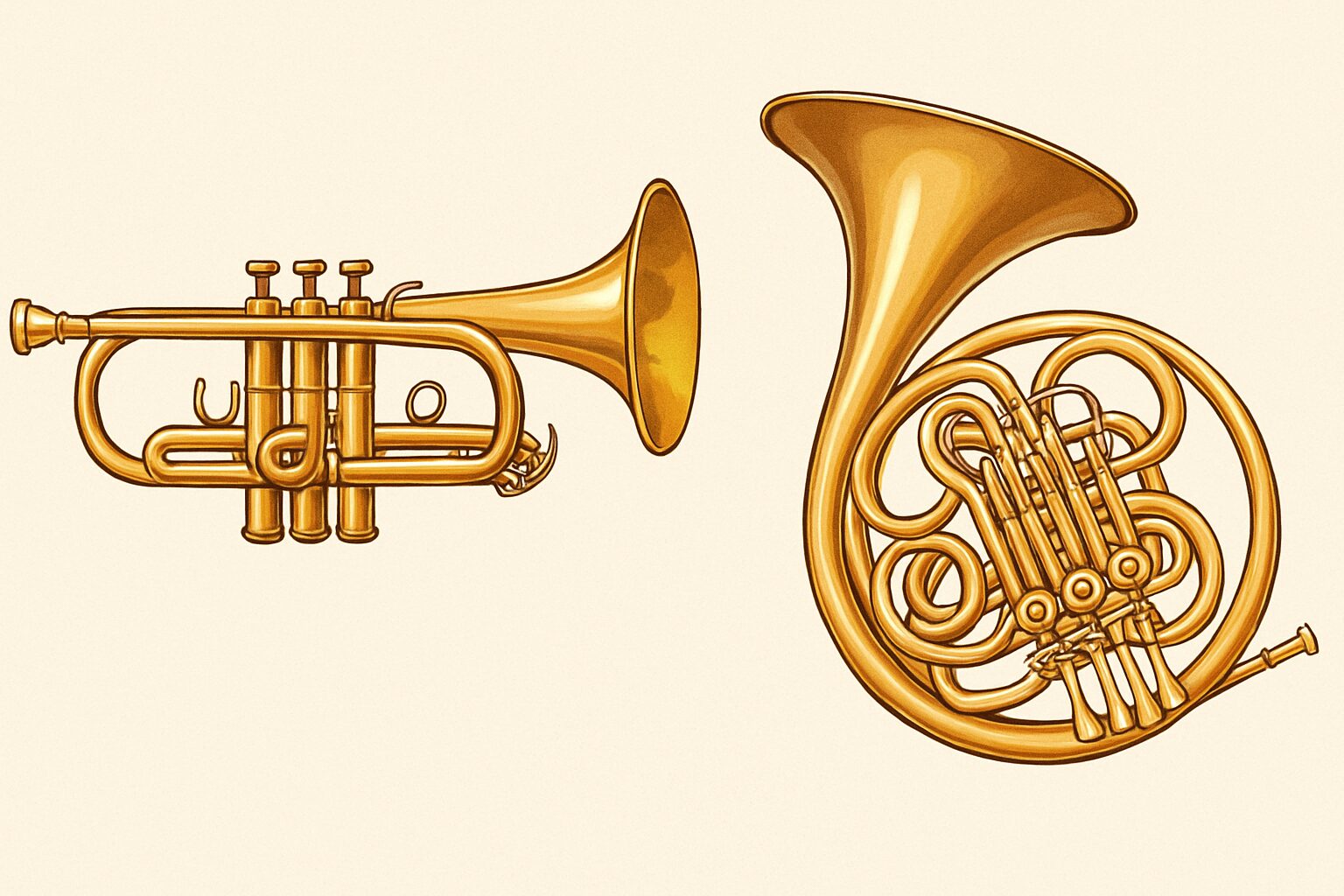Brass instruments form a vital section of orchestras, concert bands, jazz ensembles, and many other musical groups. Among these, the trumpet and French horn stand out as popular choices for aspiring musicians. While both instruments belong to the brass family and share some fundamental characteristics, they differ significantly in design, sound production, playing technique, and musical applications.
Understanding the differences between trumpets and French horns can help students, parents, educators, and music enthusiasts make informed decisions about which instrument might be the better fit based on individual preferences, physical attributes, and musical goals. This guide explores the key distinctions between these two brass instruments, examining their physical characteristics, sound qualities, learning curves, musical roles, and practical considerations.
Whether you’re considering which instrument to learn, helping a young musician make this important choice, or simply interested in deepening your musical knowledge, this comparison will highlight the unique qualities of these beloved brass instruments.
If you’re a student, check out our article over the best student trumpets here.
Table of Contents
Physical Characteristics and Design
The trumpet and French horn differ dramatically in their physical appearance and construction, which directly influences how they’re played and the sounds they produce.
Trumpet Design

The trumpet features a relatively straightforward design with:
- A cylindrical bore through much of its length before expanding into a bell
- Approximately 4.5 to 5 feet of tubing wrapped in a compact form
- Three piston valves operated by the right hand
- A cup-shaped mouthpiece with a relatively shallow bowl
- A flared bell that projects forward, away from the player
Most modern trumpets are pitched in Bb, though other variants exist including C, D, Eb, and piccolo trumpets. The standard Bb trumpet is relatively compact and lightweight, making it one of the more portable brass instruments.
French Horn Design

The French horn presents a more complex structure:
- A conical bore that gradually widens throughout its length
- Approximately 12 to 18 feet of tubing coiled into a circular shape
- Four rotary valves (sometimes five) typically operated with the left hand
- A funnel-shaped mouthpiece with a deeper, more conical cup
- A large bell that faces backward or to the side, with the player’s right hand inserted inside it
Modern French horns are commonly double horns, containing two complete sets of tubing—one pitched in F and one in Bb—accessible via a thumb trigger. This design allows for greater range and more secure high notes. The French horn’s significant length of tubing coiled into a relatively compact instrument creates a distinctive visual profile immediately recognizable in any ensemble.
According to the Hornguys Resource Center, the hand positioning inside the bell is not merely traditional but serves an important acoustic function, allowing the player to adjust pitch and tone color.
Sound Production and Tone Quality
The differences in design between these instruments directly impact their sound production mechanisms and resulting tonal characteristics.
Trumpet Sound Production
The trumpet produces sound through:
- A relatively direct pathway for air through the instrument
- Shallow mouthpiece that facilitates a more immediate response
- Bright, focused tone with pronounced upper harmonics
- Strong projection capabilities, especially in the middle and upper registers
- Distinctive brilliant timbre that can cut through dense orchestration
The trumpet’s cylindrical bore design maintains the same diameter through much of the instrument before expanding into the bell. This construction contributes to its characteristic bright, projecting sound that can range from brilliant and fanfare-like to warm and lyrical, depending on the player’s approach and the specific musical context.
French Horn Sound Production
The French horn generates sound through:
- A more complex air pathway through extensive coiled tubing
- Deeper mouthpiece that contributes to a mellower attack
- Rich, warm tone with a complex harmonic structure
- Hand placement in the bell that modifies the acoustic properties
- A more covered, rounded timbre that blends exceptionally well with other instruments
The horn’s conical bore expands continuously throughout its length, creating a warmer, less direct sound. The player’s hand position in the bell further refines the tone and can be adjusted to create subtle variations in color and pitch. These factors contribute to the horn’s reputation for a noble, majestic sound that can also achieve remarkable subtlety and expressiveness.
Learning Curve and Physical Considerations
Both instruments present distinct challenges for beginners, requiring different physical attributes and learning approaches.
Trumpet Learning Considerations
The trumpet offers certain advantages for beginners:
- More direct correlation between finger patterns and produced notes
- Visible valves and straightforward fingering system
- Relatively intuitive approach to playing higher or lower
- Compact size suitable for younger players
- Visual feedback from watching the valves
Challenges specific to the trumpet include:
- Developing lip strength and endurance for the smaller mouthpiece
- Managing breath control for sustained playing
- Building finger dexterity for rapid passages
- Achieving a centered, focused tone consistently
- Controlling dynamics, especially when playing softly
The trumpet’s more immediate response can provide encouraging results for beginners, with many students able to produce a recognizable tone within their first few attempts. However, mastering the instrument’s full range and developing the embouchure flexibility for different registers requires dedicated practice.
French Horn Learning Considerations
The French horn presents a steeper initial learning curve due to:
- Less direct correlation between fingerings and pitch production
- Hidden valves operated by the left hand while the right hand manages the bell
- More challenging initial tone production
- Greater sensitivity to slight variations in embouchure and air speed
- Complex overtone series requiring precise embouchure control
Physical considerations for horn players include:
- Larger mouthpiece requiring different embouchure formation
- Need for excellent ear training to find pitches accurately
- Right hand position in the bell affecting both tone and intonation
- Greater air capacity requirements for the longer tubing
- Upper body strength for holding the instrument properly, especially for younger players
While the horn may take longer to produce satisfactory initial results, many players find its rich, versatile sound worth the additional effort. The instrument rewards patience and careful practice with extraordinary expressive capabilities.
Musical Roles and Applications
The trumpet and French horn typically fulfill different roles within musical ensembles, though both demonstrate remarkable versatility across genres.
Trumpet Musical Applications
The trumpet often serves as:
- A lead voice carrying melodies in orchestras, concert bands, and jazz ensembles
- A brilliant, projecting presence for fanfares and ceremonial music
- A versatile soloist capable of virtuosic technical displays
- A vital section instrument in big bands and jazz orchestras
- A featured instrument in military bands and marching ensembles
Trumpets appear prominently across nearly all musical genres, from classical orchestral works to jazz, pop, mariachi, Balkan brass bands, and contemporary experimental music. Their ability to project over other instruments makes them ideal for outdoor performances and larger venues.
French Horn Musical Applications
The French horn typically functions as:
- A middle-voice instrument bridging woodwinds and brass in orchestras
- A featured soloist with a distinctively noble, singing quality
- An essential harmony voice in brass quintets and wind ensembles
- A rich coloristic element in film scores and soundtrack recordings
- A blending instrument capable of complementing both woodwind and brass sections
While most closely associated with classical repertoire, the horn has found application in film music, some jazz contexts, and even popular music. Its versatility in producing both bold, heroic statements and delicate, atmospheric textures makes it a favorite among composers seeking to evoke emotion or create distinctive sound landscapes.
Practical Considerations
Beyond musical and technical aspects, several practical factors might influence the choice between trumpet and French horn.
Transport and Space Requirements
- Trumpet: Relatively compact and lightweight, easily transported in a small case
- French Horn: Larger and heavier, requiring a more substantial case and careful handling
Maintenance Needs
- Trumpet: Straightforward maintenance with easily accessible valves and slides
- French Horn: More complex maintenance due to intricate rotary valves and extensive tubing
Ensemble Opportunities
- Trumpet: Widespread demand across multiple ensemble types and genres
- French Horn: More specialized but still valuable, with fewer players competing for positions in some contexts
Cost Factors
While specific prices aren’t discussed here, general investment considerations include:
- Trumpet: Generally more affordable entry-level options with a wide range of quality levels available
- French Horn: Typically requires greater initial investment for a quality student instrument
Frequently Asked Questions
Which is easier to learn, trumpet or French horn?
Most music educators consider the trumpet easier for beginners to start producing recognizable notes. The direct response and straightforward fingering system of the trumpet create a more immediate connection between the player’s efforts and musical results. However, individual factors like embouchure formation, prior musical experience, and personal aptitude play important roles in determining which instrument might be easier for a specific student.
Which instrument is better for a young beginner?
Physical considerations often favor the trumpet for very young beginners (elementary school age) due to its:
- Lighter weight and more compact size
- Smaller mouthpiece that may better fit younger players’ facial structures
- More straightforward initial approach to sound production
However, motivated young students with good ear training can successfully begin on French horn, particularly with appropriately sized instruments and supportive instruction.
Can skills transfer between trumpet and French horn?
While basic brass playing concepts transfer between instruments, significant adjustments are necessary when switching:
- Trumpet to Horn: Players must adapt to a larger mouthpiece, different hand positions, and a more sensitive approach to pitch production
- Horn to Trumpet: Players need to adjust to a smaller mouthpiece, more direct articulation, and different fingering patterns
Most professional musicians recommend focusing on one instrument initially before attempting to double on another brass instrument.
Which instrument offers more playing opportunities?
Both instruments offer valuable opportunities, though in different contexts:
- Trumpet: More positions available in jazz, pop, commercial music, mariachi bands, and community ensembles
- French Horn: Often fewer positions but also fewer players competing for spots in orchestras, wind ensembles, and chamber groups
The “better” opportunity profile depends entirely on the player’s musical interests and goals.
Famous Players and Influential Recordings
Examining notable performers on each instrument provides insight into their expressive capabilities and musical roles.
Celebrated Trumpet Players
- Louis Armstrong: Revolutionary jazz trumpeter whose improvisational genius and distinctive sound transformed American music
- Miles Davis: Innovative jazz musician whose exploratory approach and unique tone influenced generations
- Wynton Marsalis: Virtuoso performer equally accomplished in classical and jazz contexts
- Maurice André: Classical trumpet soloist known for extraordinary technique and musical sensitivity
- Alison Balsom: Contemporary classical trumpeter known for expanding the instrument’s repertoire and audience
Renowned French Horn Players
- Dennis Brain: Legendary classical hornist whose recordings of Mozart’s concertos set an enduring standard
- Barry Tuckwell: Prolific performer and recording artist who expanded the horn’s solo repertoire
- Philip Myers: Principal horn of the New York Philharmonic known for his powerful, secure playing
- Sarah Willis: Berlin Philharmonic hornist who has helped popularize the instrument through innovative outreach
- Radek Baborák: Virtuoso performer acclaimed for his extraordinary technique and expressive range
Conclusion
The trumpet and French horn represent two distinct voices within the brass family, each with unique characteristics and musical applications. The trumpet offers a more direct learning path with its straightforward design and immediate response, while the French horn rewards patient study with its extraordinary tonal palette and expressive capabilities.
When choosing between these instruments, consider:
- Physical attributes and preferences
- Musical interests and ensemble goals
- Learning style and patience level
- Practical considerations like transport and maintenance
Both instruments offer rich musical traditions, extensive repertoire, and valuable ensemble opportunities. The “better” choice depends entirely on individual circumstances, preferences, and goals rather than any inherent superiority of either instrument.
Whether you choose the brilliant, projecting voice of the trumpet or the warm, noble sound of the French horn, consistent practice and quality instruction will unlock the expressive potential of these remarkable brass instruments, opening doors to musical experiences that can last a lifetime.

